CRUISING
THE DANUBE
October 14–22, 2011
THE BIG
PICTURE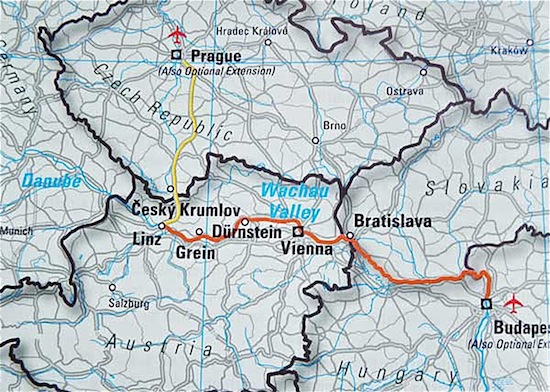
Our week of river cruising followed a wonderful week
in Prague. We boarded the
“River Avia,” operated by Grand Circle Travel, in Linz and in seven
days explored Linz, cruised
through the Wachau Valley
(with stops in Durnstein and Melk) to Vienna for two days. We stopped for
a day in Bratislava and
finished in Budapest. We
returned home via London, Boston, where we spent the night
with our daughter’s family, and then arrived in Denver in the early afternoon. It
was nearly a week before we got acclimated to a new time zone.
RIVER
CRUISING
The Danube River (the Donau in German) portion of
the trip was to be the romantic portion of our anniversary celebration:
fine dining, sipping local wines as we watched the countryside glide by
with stops in major central European capitals as Vienna and Budapest.
We booked a comfortable stateroom with sliding doors that opened on to
a narrow balcony on the top level—all the better to see the Danube
River Valley.
Of course things don’t always turn out the way you
planned anticipated, or even hoped for. The second week in October in
central Europe can be mild and sunny. So folks there say. Ours was not:
gray skies a lot of the time and chilly weather made sitting outside
quite uncomfortable. The occasional showers drove us inside where we
watched the countryside glide by from the lounge of the ship. The
lesson we learned is that unless you have a guarantee from an
omniscient weather god, anticipate nothing and everything.
LINZ
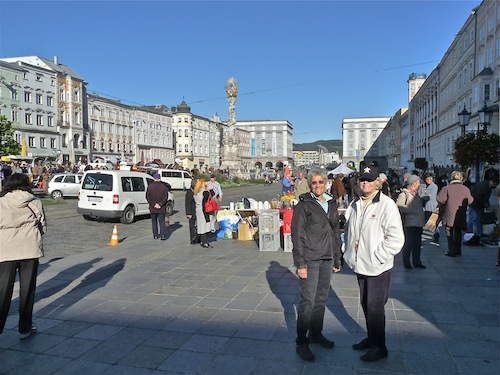
Our lasting memory of Linz will likely be the
flea market extravaganza in the main city square or Hauptplatz. (Does
this happen every Saturday, or did we just hit it lucky?) Surrounding
the Pestsaule or “Plague
Column” that honors victims of the many plague epidemics that swept
through central Europe, were row after row of vendors (some
professionals, some once a year folks getting rid of some unwanted
stuff) offering everything from kitchenware to old magazines, Nazi
ephemera, clothing, rugs, antiques, and furniture. You name it, they
had it. Hughes was able to finally find his single souvenir of the
trip: Skoda
ball caps: one for him and one for all the guys in the family. We also
found an antique china box to add to Cindy’s collection. We would have
purchased more if we had taken the time and had more room in our
luggage to take things home. Even so, we had a great time looking
through what was available.
While in Linz, we took on a mission to bring back a
linzer torte for our daughter. We thought we could find them most
anywhere in Austria, but it seemed one from Linz would be truly
authentic. Hughes walked down the main street (Landstrasse) and found Backerei Hofmann which proudly
announced in their window: “Home of the Original Linzer Torte.” It must
be true if they said so. Their largest one was nearly 15" and it came
in a sturdy, decorative box. Mission accomplished! It got back to
Boston in fine condition.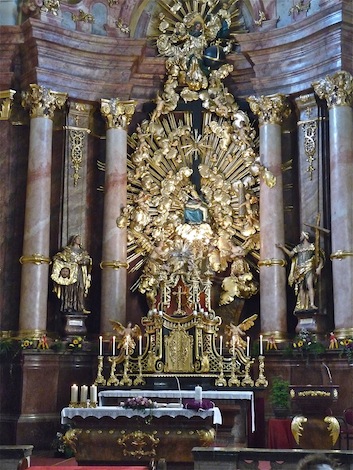
Just a few blocks south and west of Hofmann’s is the
beautiful New
Cathedral or Mariendom, an impressive neo-Gothic structure begun in
the mid-19th century and consecrated as the Cathedral of the Virgin
Mary in 1924. It seats 20,000 and is considered the largest church in
Austria. Among its many stained glass windows is the “Linz Window” that
depicts the history of the city. The cathedral was also planned to be
the tallest, but was officially denied that honor in favor of Vienna’s
St. Stephen’s Cathedral (although there is some claim that the cross on
the top of the spire is more that two meters, therefore making Linz’s
cathedral taller).
However, the tallest spires in Linz must surely be
those atop the the Postlingberg Church
that overlooks the city over 1,700' below. Built in the 18th
century, this Baroque “pilgrim” church has survived several fires,
Napoleon’s army, and decades of neglect. It managed to escape Allied
bombing during WW II in spite of Linz being a strategic target. It can
be reached by the Postlingbergbahn,
an “adhesion” mountain railway that offers a leisurely view of Linz and
the surrounding Danube Valley during the 7-minute, 1.67 mile journey
from the center of town to the top. It It was constructed over 100
years ago and still uses trolley poles that connect to an overhead
power line. Unfortunately, the day we were there, the trolly was in the
shop for repairs so we took a bus up the twisting road to the top. The
views were outstanding and the walk around the church was relaxing and
very pleasant in the warm afternoon.
[When
we returned to our cabin that afternoon, there was a personal note from
Agus, our room steward wishing us a happy anniversary (and a pair of
“swan towels” arranged in the shape of a heart) plus a bottle of
champagne, two glasses, and a note from the captain and crew also
wishing us a happy anniversary. Both nice touches.]
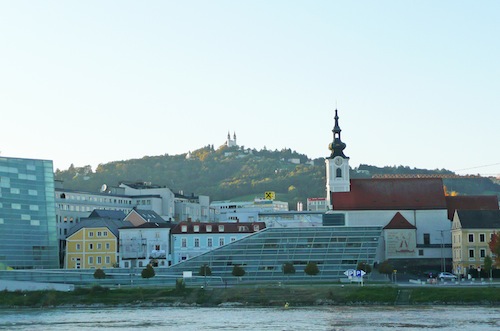
The city and the suburbs of Linz are home to, or
associated with many famous people, including Johannes Kepler (17th
century astronomer, mathematician), Anton Bruckner (19th century
composer and organist), Rainer Maria Rilke (20th century poet), Mozart
(who visited briefly, probably for the linzer tortes, long enough to
write his Symphony No. 36, the “Linz Symphony,” in 1783); and two
of the nastiest people in history: Hitler and Eichmann.
We are pretty sure we just barely scratched the
surface in our explorations of Linz; there is much more to see and
discover in a city of nearly 200,000. We had just a day, and the flea
market was an unexpected/unscheduled attraction. For certain we missed
two potentially interesting museums: the Lento Art Museum
(19th and 20th art) situated on the south side of the river near our
ship, and the unusual Ars Electronica Center, on the opposite side,
that houses scientific and technological displays, many of which are
interactive. The building is covered with over 1000 glass panels, each
equipped with an LED bar the allow it change its color, which it does
in the evening. Time constraints also forced us to miss the Mozarthaus,
the Linzer Schloss (Linz Castle), and the Museum of the History of
Dentistry in Upper Austria! This is a city we could return to and learn
even more.
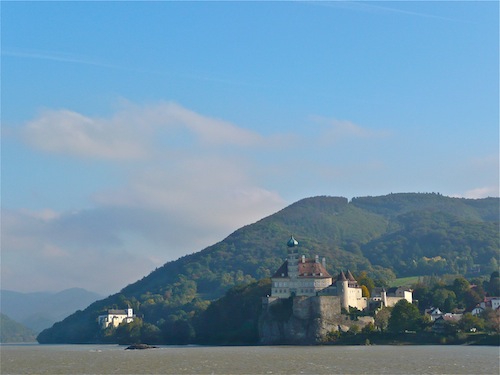
THE WACHAU
VALLEY
Even with the drizzle and gray skies, there is an
undeniable beauty and peaceful quality to this hilly region noted for
its vineyards and fruit trees. The 25-mile stretch of the Danube
between Melk and Krems is a World Heritage Site, so designated for its
cultural landscape and long history of people living here: there is
evidence of human habitation 30,000 years ago. In addition to fine
wines, the fruit schnapps, especially marillen
(apricot) we sampled were as sweet—and strong—as anything we’ve tasted.
There are also in this region heurigen, or wine taverns, owned and
operated by different wine growers. Though they are not open throughout
the year, a wreath or a decorative bunch of twigs above the entrance
indicates the wines are in and visitors are welcome. They may or may
not serve a buffet or meal with the wine.
The roads that paralleled the river were no longer
crowded with bicyclists as they were the previous summer months. There
is a bike path through the Valley which makes possible a three-hour
ride from Melk to Krems on both sides of the river. It’s a trip we
would glad take; or go even father, camping along the way or staying
small local inns. We made two stops that afternoon: at Durnstein and at
Melk.
•Durnstein.
As we rounded a bend in the river we saw an impressive light blue
painted tower which, we learned later, belonged to the the 18th century
Durnstein Abbey,
now the parish church in Durnstein. It is striking not only for its
colorful exterior (it was the only light blue church we were to see on
the trip) but also for the design of the steeple that stands out from
the more traditional red roof and stone design of the abbey buildings.
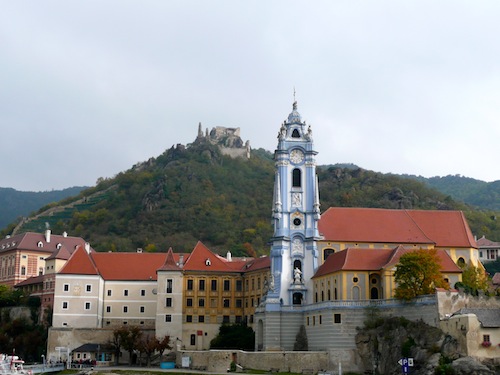
In the background on the hill overlooking the town
is the much older ruins of the Durnstein
Castle. A 20-minute walk up the steep hill takes visitors to the
castle and a magnificent view of the Wachau Valley. (Two routes take
you to the summit; the rocky trail is to the left as you leave town;
the righthand route is smoother and can be walked in ordinary street
shoes.)
The Castle figures prominently in English history as
the place where Richard I (the “Lionheart” or “Lion-Hearted”) was
imprisoned briefly when, upon returning from the Third Crusade in 1192,
he was captured and imprisoned by Leopold V of Austria on suspicion of
the murder of his cousin while in Jerusalem. We saw the iron bars of
the cell where Richard was held until a ransom was paid to free him so
he could return to England and help save Robin Hood from the Sheriff of
Nottingham (or so goes the movie). The Castle itself was destroyed in
1645 by Swedish troops and left in the condition we saw.
After walking back from the Castle, we strolled
along the one main commercial street of the small town, tasting samples
of marillen at various shops, eventually buying two small bottles of Wachauer
Premium Marillenlikör, which, sadly, does not seem to be
available in this country. Our loss.
•Melk Abbey.
This impressive Benedictine
monastery was founded in 1089 and has been a seat of learning ever
since. The present complex of buildings was built in the first part of
the 1700s and because of its great importance and stature, it managed
to escape confiscation and destruction during the Nepolianic Wars; in
fact, throughout its existence only the Nazis seized the Abbey but
apparently did it no harm. It was returned following the end of the
Second World War. It continues as a co-ed school with about 900
students.

The church is as amazing in its ornate use of gold
in the alter, pulpit, naves, and the rest of the interior. Paintings
and frescoes can be found throughout, and the museum, which we toured,
shows the history of the Abbey since its founding. The library,
however, is famous as a significant scriptorium, both producing
manuscripts as well as for maintaining the library which has
approximately 100,000 items: manuscripts of both music and liturgical
writing, books, and incunabula dating well before the 16th century. The
tour went far too quickly to grasp the full extent of this structure
and all that it stands for.
We walked briefly through the quiet town of Melk
which, like other medieval towns we visited, had cobblestone streets,
pastel plaster buildings, and a quiet sense of its historical
importance.
[Note:
The night we left for Vienna we got word that a tummy bug was making
its way through the passengers and crew. About 30 of the passengers
(out of 160) were down for at least one day, some longer. It sounded
like the sort of thing we have picked up while in Latin America where
bad water was the culprit. Here we’re not sure of its source except we
were told that it travels from person to person. Wash hands a lot was
the best advice. We avoided the malady, though several of the folks we
spent time with were confined to their rooms for a day or two. No fun.
Everyone appeared to be OK by the end of the trip.]
VIENNA
We toured the magnificent Vienna State
Opera House (Wiener Staatsoper)
in the morning. There was, of course, no activity, but walking through
the hallways, rooms, and the theater itself was as impressive as any
art museum. Wonderful frescoes, friezes, paintings, and sculptures are
found throughout. It would have been an incredible experience to attend
a performance there.
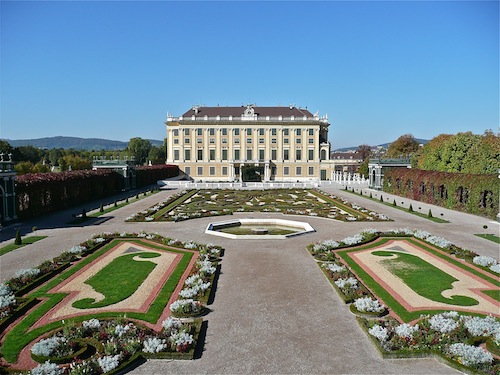
When the group broke up after the tour, we joined
David and Caroline for our own tour of the Schonbrunn
Palace, the summer residence of the Habsburgs on the
outskirts of the city. Schonbrunn is the Austrian version of
Versailles, both in size and grandeur. The gardens were beautiful and a
pleasure to stroll through. We spent so much time going from room to
room, listening to the audio guide which was excellent, we did not take
advantage of visiting the zoo or the Grosses
Palmenhaus (Great Palm House) or Wustenhaus (Desert House).
Visitors really need to spend the day, take frequent rest periods, and
snack occasionally for energy in order to properly see all there is to
see. We spent only a half day at most.
We did have our pastry that day at the famous Cafe Sacher, home
of the legendary Sacher
Torte. The cafe was small, crowded, and, alas, the torte did not
match its reputation. Most pastries we had in Prague we considered far
superior. Oh, well. Afterwards, we walked to St. Stephens Cathedral,
Austria’s main cathedral. Its rival, the New Cathedral in Linz, was as
impressive both the outside and the interior.
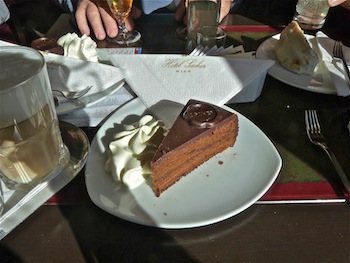
The following morning we watched the Lippizaner Stallions
practice at the Spanish
Riding School. What a treat, not to be missed! In the same arena
where they evening performances, we were treated to twenty horses in
four groups of five go through their exercises for a half hour (each
group of five). They did not do all the leaps and “tricks” that are in
their repertoire and they did not work in unison, but watching
these talented horses and riders was a real treat.
We were surprised to see one of the twenty horses
exercising that morning was not white (probably a bay, since we later
learned that it is traditional to have at least one bay Lippizan among
the group.) Lippizans are bred to be gray—they are not white horses—and
may be born with any number of different color coats. The graying
process is usually completed between six to ten years. The history and
traditions of the Lippizans is well documented and go back hundreds of
years. They have been the subject of many books and films, perhaps best
remembered is Disney’s “Miracle of the White Stallions,” which
dramatized saving the horses during World War II.
We walked to the Naschtmarkt,
5-6 blocks of solid food: cafes, restaurants, produce, spices, meats
and fish, baked goods, liquors, and a few non-food vendors (we found a
lovely scarf there for our grand-daughter). The narrow street was
jammed with folks eating or looking or buying fresh goods. The choices
were overwhelming and great fun to browse through for exotic foods and
produce.
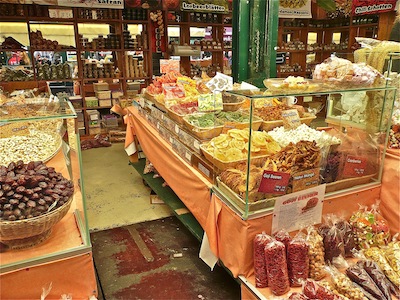
We took the trolley through the city and got off at
a subway that took us back to our ship in time for dinner. As we
approached the ship’s dock, we finally paid attention to a beautiful
church we’d overlooked in our haste to get to town each day: Franz-von-Assisi
Kirche (also called the Emperor Jubilee Church or the Church of
Mexico!), designed in the late 19th century in the “Rhenish-Romanesque”
style, making it unique among the churches we saw on the trip. It was a
haven of calm and beauty against the backdrop of high rises and
traffic. We should have visited it sooner.
We found Vienna high-powered, bustling,
self-important, impersonal, and expensive. There are dozens of museums,
events, and places to explore. We might have done more had we spent
more than two days there, but we were honestly glad to have had two
days and no more. Maybe we are getting travel weary? We might come
back, but probably it would not be high on our list of return visits.
BRATISLAVA
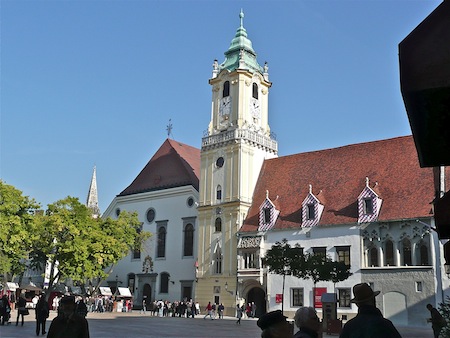
Once the capital of the Kingdom of Hungary (in
1536–1830), now capital of Slovakia, Bratislava
(formerly Pressburg) was first settled by Celts (here they are again)
in third century BC. The Romans conquered in the first century AD,
followed by the Slavs who founded Moravia. The Hungarians established
the Kingdom of Hungary in the 9th century. The city was absorbed into
the Austro-Hungarian Empire until the end of WW I when it became part
of Czechoslovakia and many Hungarians fled, leaving their homes to
Czechs and Slovaks. The Nazi occupation was followed by Communist rule
until the Velvet
Revolution of 1989. In 1993 Bratislava became the capital of the
Slovak Republic after the “Velvet Divorce.”
Today Bratislava is a city of about half a million
nestled snugly on the banks of the Danube. It may lack the sparkle and
dynamic atmosphere of Vienna and Prague, but offers visitors a calmer
pace with a relaxed Baroque/Middle Ages feel. If many of the buildings
in the old part of the capital are in need of paint and repair, there
are modern office buildings, museums, concert halls and theaters that
also define this city—a mix of the old and new, some built during the
Communist period, some in the 2000s following the country’s
independence.
Our morning guided tour was through the Old Town
section near the river: what we did see was charming but limited to
what was old, rather than parts of the city built since independence.
Happily we did find:
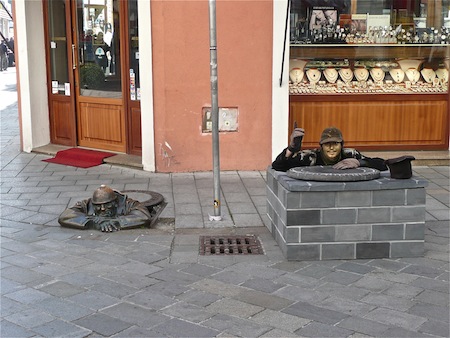
•Strong hot chocolate at Cafe
Maximillian, a well-known upscale chocolaterie. Sinful, but we
needed to get off our feet and warm up on what was a chilly morning.
•Several whimsical bronze statues are scattered
around the Old Town. We could identify Hans Christian Anderson and a
Napoleonic soldier, but we learned about the others: “Paprazzo,”
“Schoner Naci (who tips his hat to all the pretty girls who pass”) and
the most photographed statue: “Cumil” (“the peeper”) who seems to be
looking out from a sewer watching people going through the old town
center. Next to him was a fellow mimicking the statue but with his hat
out.
•Novy
Most (the “New Bridge,”) over the Danube was erected during the
Communist period, completed in 1972. Its flying saucer shaped
restaurant on the top of the bridge’s only pylon is certainly
distinctive. Most memorials to the Communists that could be removed or
destroyed have been, but the flying saucer restaurant and observation
tower are stand out and bring in some revenue (7 Euros): as Rick Steves
wrote, built in “heavy-handed communist …reclaimed by capitalists.” The
north side of the bridge went right in front of St. Martin’s
Cathedral—nearly cutting off the entrance—and many houses and buildings
in the predominantly Jewish section were torn down to make way for the
approach to the bridge.
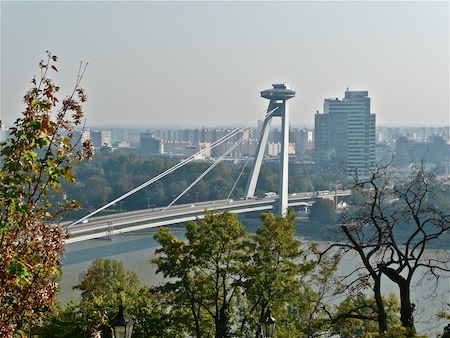
•Bratislava Castle
offers the best views of the bridge and the city itself. It is not the
original used by the Habsburgs: Empress Maria Theresa loved Bratislava
and converted the castle from a military facility to a royal residence.
Locals nicknamed it “little Schonbrunn.” However, a fire in 1811
destroyed it and it was not reconstructed until the Communist period
(1953). The result is unimaginative and drab; the courtyard more like a
prison exercise area. However, the the city views are excellent.
•It is clear from the number of young people out and
about that Bratislava is a university town. Comenius University enrolls
10,000–15,000 students offering degrees in medicine, law, sciences,
pharmacy, education, management, and general studies.
Old Town Bratislava is changing, at least that’s
what everyone says. It does need some TLC: paper and plastic litter in
lots of areas (must be those darn college students!), plaster cracking
and paint peeling on many of important buildings (darn Communists!). We
did not see the newest sections, and that may well have
changed/improved our impression of the city.
BUDAPEST
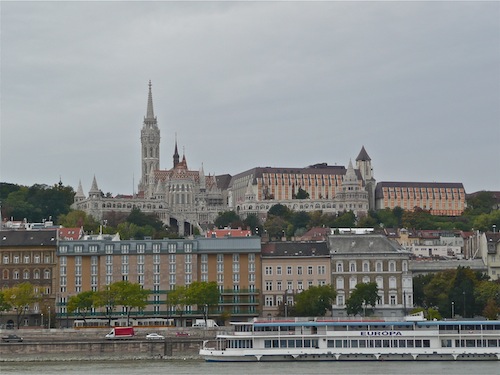
Buda on the south side of the river (Buda Castle
is on Buda Hill) and Pest on the other side (Parliament
Building dominates the north shore). This World Heritage Site with
1.7 million people in the city, twice that in the surrounding area, has
been unified into one city since 1873.
First settled by the Celts (surprise!), then the
Romans, then the Hungarians (Magyars), pillaged by the Mongols, but
reclaimed by Hungarians, ruled by Ottomans, Habsburgs, Nazis, and
Communists until 1989, when Hungary once again regained its freedom and
independence. The city boasts the world’s second oldest
underground/subway (after London), 80 geothermal springs, and the
second largest synagogue (the Dohany Street Synagogue consecrated in
1859) which is part of Budapest’s Jewish section with a Jewish Museum
much like the one in Prague.
Our visit to Budapest was, unfortunately, limited to
a single day. During our short guided tour portion, we were bused to
the Castle District which overlooks the Danube and Pest. However, what
we and other modern visitors to the castle see today is not the
original castle that grew from a fortified village in the 13th century,
nor the palace built up by the 15th century. These buildings, which
have been described as one of the greatest palaces in Europe, were
destroyed during Turkish rule that ended in the 17th century. Much of
the “new” palace built by the Habsburgs in the 1700s was destroyed by
fire in 1810, but was added on to later in the 19th century. During the
World War II and the Communist period, the palace was gutted and the
interiors of the time of Maria Theresa and Franz Joseph were mostly
destroyed. Finally in 1966, the palace was rebuilt, though plans are
still in place for completing the interiors. Truly, the castle has a
tumultuous history and remains a work in progress.

We admired the decorative tile design of the roof
but we did not tour the interior of the castle. We also admired, in the
same area, the fine needlework and traditional dolls for sale in the
many shops that line the streets leading to the castle. No bargains to
be had, but on the other hand, when you see how much handwork was
required—in addition to the artistry—you could not expect folks to sell
the items for less.
We were bused across the river for a driving tour of
Pest:
•Parliament Building, a magnificent building which
looks remarkably like London’s House of Parliament.
•Heroes’
Square, a large open area surrounding the Millennium Memorial
honoring those who gave their lives for the independence of Hungary
over the centuries, as well as statues of leaders of the seven founding
tribes. The Museum of Fine Arts and the Palace of Art are on either
side.
 •The Great Market Hall is a multi-level complex of shops featuring all
manner of produce, meats, spices and teas, and, on the upper level,
tourist goods (embroidery, crafts, etc.). Every kind of paprika
imaginable is available for sale.
•The Great Market Hall is a multi-level complex of shops featuring all
manner of produce, meats, spices and teas, and, on the upper level,
tourist goods (embroidery, crafts, etc.). Every kind of paprika
imaginable is available for sale.
After lunch on board the “River Aria,” Judy went for
a run along the waterfront and Hughes headed for a walkabout in Pest.
As we both headed down along the waterfront (“Danube Promenade”), we
passed what was for us the most chilling monument of the entire trip: a
row of sixty
bronzed shoes along the water’s edge, in a random line of pairs and
some single shoes clearly of men, women, and children. We were so taken
with the shoes that we did not see the plaque that explains what the
shoes represent or whose they were. We were to learn that this was the
site where, in 1944–45, Nazis and members of the “Arrow Cross” (a local
militia) “routinely” shot men, women, and children in the back while
chained together and let their bodies (without their shoes) fall into
the Danube. The effect on us of this Holocaust Memorial was more
powerful than the Prague Ghetto.
Hughes strolled through the narrow streets of the
area behind the Parliament Building, ending up at St. Stephan’s
Basilica, named in honor of Hungary’s first King (975 AD). His right
hand can be seen in the reliquary. The basilica is a beautiful
Neoclassical structure completed in 1905. He spent so much time there
that he didn’t get to the equally famous and outstanding Dohany Street
(“Great”) Synagogue a few blocks away. That visit will have to remain
for a future trip to Budapest, as will any of the famous bath houses
and museums, Margaret Island, and Gallert Hill.
FINAL
EVENTS AND REFLECTIONS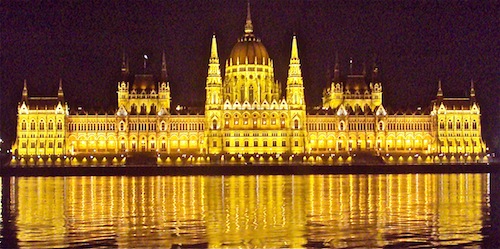
At dinner that last evening aboard the “River Aria,”
the captain’s table was filled with tour directors and selected guests.
The entire crew joined in putting on a series of humorous skits after
dinner, and we all went to our bedrooms to pack for early departures in
the morning.
Our two weeks were filled with new sights in areas
of the world we had only read about. Prague was remarkable; everyone we
have talked with since our return had either been there and were as
impressed as we were, or wanted to go because they heard what a
wonderful city it was to visit. Our time on the Danube went by all too
quickly: we saw a little of the countryside since most of the movement
of the ship was at night, and our time in any of the cities where we
stopped was limited to one day, except for our two days in Vienna. We
learned a lot and saw places we had only vaguely known from reading or
movies/documentaries.
We enjoyed our traveling companions a great deal.
Most were around our age, most were experienced travelers who had been,
collectively, everywhere, and they knew how to travel. Most fortunately
we were guided by Tereza, who made our visit to each of the
countries/cities on the trip comfortable and rewarding.
Would we return? To Prague, for sure. Budapest?
Probably, since we know there was much more to see and learn about that
city. The Danube? What fun it would be to bicycle along this
mighty river and learn about the folks who live in the small towns
along the way. And if we’re in the area of Linz on a Saturday,
we’ll hope the flea market in the Hauptplatz is in full swing again.
















 •The Great Market Hall is a multi-level complex of shops featuring all
manner of produce, meats, spices and teas, and, on the upper level,
tourist goods (embroidery, crafts, etc.). Every kind of paprika
imaginable is available for sale.
•The Great Market Hall is a multi-level complex of shops featuring all
manner of produce, meats, spices and teas, and, on the upper level,
tourist goods (embroidery, crafts, etc.). Every kind of paprika
imaginable is available for sale.
